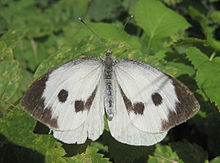Large white
| Large white | |
|---|---|
 |
|
| Male | |
 |
|
| Female | |
| Scientific classification | |
| Kingdom: | Animalia |
| Phylum: | Arthropoda |
| Class: | Insecta |
| Order: | Lepidoptera |
| Family: | Pieridae |
| Genus: | Pieris |
| Species: | P. brassicae |
| Binomial name | |
|
Pieris brassicae (Linnaeus, 1758) |
|
| Synonyms | |
|
|
Pieris brassicae, the large white, also called cabbage butterfly, cabbage white, cabbage moth (erroneously), or in India the large cabbage white, is a butterfly in the family Pieridae. It is a close relative of the small white, Pieris rapae.
The large white is common throughout Europe, North Africa, Asia even through the Himalayas.
The large white is common throughout Europe, north Africa, and Asia to the Himalayas often in agricultural areas, meadows and parkland. It has managed to establish a population in South Africa and in 1995 it was predicted to spread to Australia and New Zealand.
The large white is a strong flier and the British population is reinforced in most years by migrations from the continent. Scattered reports of the large white from the north-eastern United States (New York, Rhode Island and Maine) over the past century are of a dubious nature and indicate either accidental transport or intentional release. Such introductions threaten to establish this agricultural pest in North America.
In 2010 the butterfly was found in Nelson, New Zealand where it is known as the great white butterfly. It is classed as an unwanted pest due to the potential effect on crops. For a limited period in October 2013 the Department of Conservation offered a monetary reward for the capture of the butterfly. After two weeks, the public had captured 134 butterflies, netting $10 for each one handed in. As a result of this and other containment measures, such as over 263,000 searches in the upper South Island and the release of predatory wasps, the large white was officially declared to be eradicated from New Zealand as of December 2014.
The large white eggs appear as a pale yellow colour. They turn into a darker yellow within twenty-four hours of being oviposited. A few hours prior to hatching, they will become black in colour, and the shell will become more transparent, and the larvae will appear visible.
...
Wikipedia
